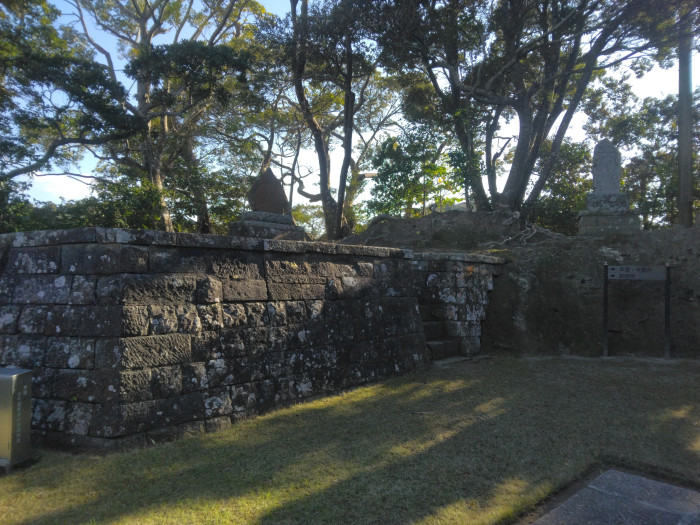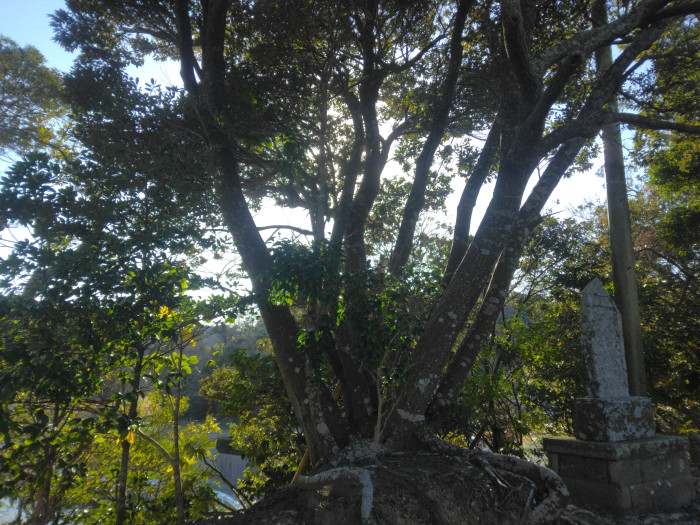大原公園内の遊歩道から一般の道路へと迂回する。先の看板まで歩いて、静かな水面の”大聖寺堰”に出る。駐車場へと至る道である。と、目指す”阿舎羅山 大聖寺”へと続く石段が伸びていた。
walked to the sign seen before and came upon the calm waters of "Daisho
Temple Weir". Here was the path that led to the parking lot. Then we came
across stone steps leading to our destination, "Asharasan Daisho Temple".

海の町らしく、境内へと続く階段の手前に、南国の植物のソテツが植わっている。何やら仲良しの姉妹兄弟や親子のようで、愛嬌がある。家族全員が奇抜な髪形をしている感じに、ついついほくそ笑んでしまう。
Like a seaside town, there are tropical cycads planted just in front of the stairs
leading to the temple grounds. They looked like friendly sisters and brothers,
and parents and children, so they were very charming. I imagined that the
whole family had unusual hairstyles. Therefore, I couldn't help but smile.

”阿舎羅山 大聖寺”は、関東三十六不動霊場第35番札所の天台宗の寺院である。別名を、”波切不動尊”と言う。
関東三十六不動霊場とは、不動明王を祀っている南関東にある36寺院により1987年に開創された。都県によって役割が分担されており、神奈川県にある7寺は”発心の道場”、東京都にある19寺は”修行の道場”、埼玉県にある5寺は”菩提の道場”、千葉県にある5寺は”涅槃の道場”の札所となっているとのことである。
"Asharasan Daisho Temple" is a Tendai sect temple and the 35th temple issuing amulets in the Kanto Thirty-six Fudo Sacred Place. It is also known as "Wave
Ctting Fudoson."「波切不動」の名は、唐から帰国中の空海が、荒れた海を沈めようと不動明王を海に沈めた伝説に由来する。その不動明王は、右手に持つ剣で荒れ狂った波を切り裂き、そのお陰で、空海一行は難を逃れて帰国できたそうである。空海は帰国後、航海の無事に貢献してくれた不動明王を高野山に奉納した。こうして「波切不動」の信仰が始まったそうである。そこから、海難除けや大漁祈願など、海に纏わる祈願を集めている。
The Kanto Thirty-six Fudo Sacred Place was established in 1987 by 36 temples in southern Kanto that worship Fudo Myoo. Roles are divided by prefectures,
and 7 temples in Kanagawa Prefecture are "dojos for awakening", 19 temples in Tokyo are "dojos for training", 5 temples in Saitama Prefecture are "dojos for
enlightenment", and 5 temples in Chiba Prefecture are "dojos for nirvana".
The name "Wave Cutting Fudo" came from the legend that Kukai, who was
The name "Wave Cutting Fudo" came from the legend that Kukai, who was
returning from China, sunk Fudo Myoo in the sea to calm the rough seas. The
Fudo Myoo cut the raging waves with the sword in his right hand. By its brave
action, Kukai and his party were allowed to come back to Japan safely. After his return, Kukai dedicated the Fudo Myoo to Mount Koya for its contribution to
their safe voyage. This is how the faith to "Wave Cutting Fudo" began. Since
then, it has gathered prayers related to the sea, such as protection from
disasters at sea and prayers for a good catch.

ここ、いすみの「波切不動堂」にも、不動明王が祀られている。その経緯は、宝治2年(1248年)の鎌倉時代に遡る。地元の漁師である小浜道猷の妻が、丹が浦の海で海藻を採取していると、偶然、海中に沈んでいる不動明王像を発見した。妻はそれを拾い上げ、ここに安置したことが寺院の始まりだそうである。
それ故、今でも地元の漁業に関係する方々から厚い信仰を集めている。
origins date back to the Kamakura period in 1248. When the wife of local
fisherman, Kohama Doyu took seaweed in the sea of Tangaura, she
accidentally discovered a statue of Fdo Myoo submerged in the ocean. She
picked it up and enshrined it here. It's the beginning of this temple.
For the reason, it still receives strong faith by people involved in the local fishing industry.
For the reason, it still receives strong faith by people involved in the local fishing industry.

階段を登った先に建立されているのは、大聖寺の中心的な建造物とされている波切不動堂である。建立は、建築様式の特徴により室町時代後期(1467年~1572年)と推定されている。その特徴が、禅宗様と和様を見事に融和した組物と頭貫の木鼻に表れている。
considered the central structure of Daisho Temple. Its construction is estimated to have been in the late Muromachi period (1467-1572) due to the
characteristics of the architectural style. The characteristics is shown on the
combination of the pillars and the crossbars under the roof, which beautifully
blend Zen and Japanese styles.

茅葺きの屋根は、一重の寄棟造りである。
This building was designated an Important Cultural Property by Japanese
この建築は1916年(大正5年)5月20日に、国により重要文化財に指定されている。
The thatched roof is the single layer hipped roof structure.This building was designated an Important Cultural Property by Japanese
government on May 20, 1916.

不動堂の向かいには、奇麗に組んだ石垣で囲われている高台がある。他人が登ることを想定していないのではないだろうか。人一人ほどの狭い石段は、足元が荒い。高台の縁まで寄ると、樹々の向こうに”大聖寺堰”が一望できる。
Opposite the Fudo Hall, there was a hill surrounded by the beautifully
constructed stone walls. I wondered that no one was planning to reach the
surface of the hill. The stone steps were narrow enough, only the width of one
person, and its surface was rough. When I got close to the edge of the hill, I
could see the Daisho Temple Weir beyond the trees.

右手には、故陸軍工兵の墓が立っている。
On the right side, the grave of a late Army engineer stood.

左手の茶色い石には”不動尊門柱敷石寄附芳名碑”との文字が深く刻まれているので、寄付者を記念した石碑のようである。近づいてよく見ると、名前と寄付金額とが一面に薄く刻まれている。
Gate Pillar, Paving Stone, name of Donation Monument" were deeply engraved. It looked like a monument commemorating donors. Looking closer, I see that a
lot of names and donation amounts were lightly inscribed around the words.

手水舎の隣で勢いよくに枝葉を伸ばしているのが、御神木である。無数の根が、貪欲な腕のように地中へと伸びている。幼子のような石祠が寄り添っている。悲喜交々の長い月日を、ただじっと、共に過ごしてきたのであろう。穏やかな様子である。
That tree with vigorously growing branches and leaves next to "Chozu-sha", is
the sacred tree. Its countless roots stretched into the ground like greedy arms.
The small stone shrine like a baby nestled deeper against the tree. They must
have just stayed still and spent a long time together, filled with joys and
sadness. They had the peaceful atmosphere.















